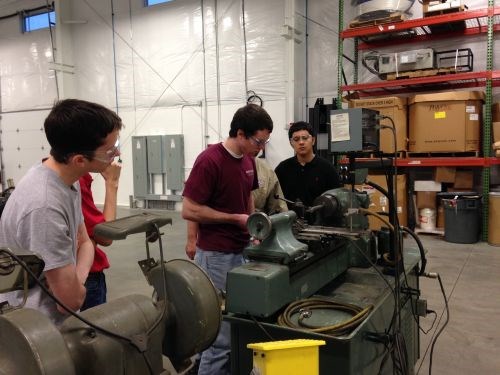Attracting the Younger Generation by Convincing the Older
According to some of those on the front lines of the battle to spread the word about manufacturing career opportunities, support from parents is critical to any outreach effort.

Prospective apprentices undergo “orientation week” at Superior Tooling, a founding member of the North Carolina Triangle Apprenticeship Program (NCTAP). As is the case with EAMA and Apprenticeship 2000, detailed below, this program purposefully includes parents in its outreach efforts. Click here to learn more about NCTAP. (Photo courtesy of Superior Tooling.)
Attracting young people to manufacturing careers requires getting through to not just kids and teens, but older generations as well.
So says Ray Coombs, president of Plainfield, Connecticut mold manufacturer Westminster Tool. Rest assured Coombs knows quite a bit about spreading the gospel of manufacturing. After all, Westminster’s workforce development efforts are among the myriad factors that won it this year’s Lead Time Leader award. Coombs is also president of the Eastern Advanced Manufacturing Alliance (EAMA), a diverse group of 34 manufacturers that collaborate to promote manufacturing as a career option and influence the curriculums of local community colleges.
As part of that effort, Westminster periodically hosts open houses for local high school students—and, critically, their parents or guardians. During our conversations for the Lead Time Leader article, Coombs offered an interesting anecdote about one of these events that illustrates why including parents is so important. “After we took them through the shop, we wanted to know how many in the group had expected to see anything similar to what we showed them out on the floor—whether they were previously aware of what a modern manufacturing environment looks like,” he recalls. “About 90 percent of the kids raised their hands, but only about 10 percent of their parents did. It seems to me that we are doing a great job of changing students’ perceptions, but not necessarily their parents’ perceptions.”
Coombs isn’t the only one who thinks it’s critical to include parents in outreach efforts. Steve Rotman is president of Ameritech Die and Mold, a founding member of Apprenticeship 2000. He recently commented on the importance of including parents in the apprenticeship program’s introductory facility tours and other outreach efforts. Of course, the fact that students graduate with four years of experience and a two-year degree from a community college—all paid for by the host company—also helps convince parents that apprenticeship can be a viable alternative to traditional four-year university. “Once (parents) understand that this isn’t exactly their idea of what manufacturing looks like, they’re committed, just like they would be if the student were going off to a traditional college,” he says.
Check out this Q&A for more of Rotman’s thoughts on his experience with Apprenticeship 2000 (including an anecdote about how at one point, even he was reluctant to encourage his own son to pursue a manufacturing career). In the meantime, keep in mind that today’s bright-eyed, enthusiastic students didn’t live through the painful hollowing-out of the U.S. manufacturing sector. Parents, on the other hand, might be understandably wary of their kids entering the field, despite the recent resurgence. And when sons and daughters begin evaluating career choices, parents could very well wield enough influence to tip the balance.
Read Next
Reasons to Use Fiber Lasers for Mold Cleaning
Fiber lasers offer a simplicity, speed, control and portability, minimizing mold cleaning risks.
Read MoreHow to Use Continuing Education to Remain Competitive in Moldmaking
Continued training helps moldmakers make tooling decisions and properly use the latest cutting tool to efficiently machine high-quality molds.
Read MoreAre You a Moldmaker Considering 3D Printing? Consider the 3D Printing Workshop at NPE2024
Presentations will cover 3D printing for mold tooling, material innovation, product development, bridge production and full-scale, high-volume additive manufacturing.
Read More

















